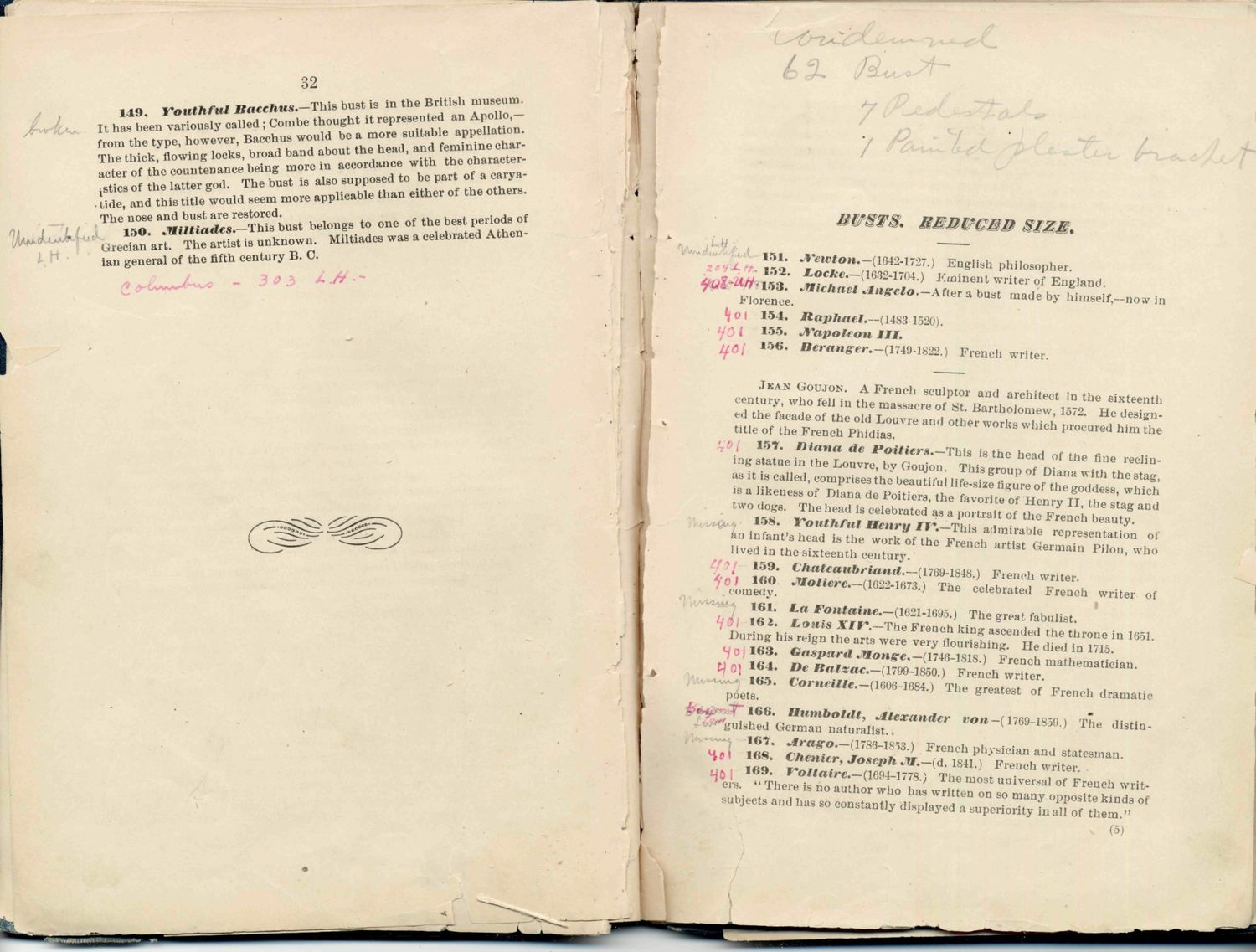| |
| |
Caption: Book - Gregory Art Collection Catalog (Gregory)
This is a reduced-resolution page image for fast online browsing.

EXTRACTED TEXT FROM PAGE:
32 Jr^rlO-*1-49. Youthful Bacchus.—This bust is in the Britisli museum. I t has been variously called ; Combe thought it represented an Apollo,— from the type, however, Bacchus would be a more suitable appellation. The thick, flowing locks, broad band about the head, and feminine character of the countenance being more in accordance with the characteristics of the latter god. The bust is also supposed to be part of a carya• tide, and this title would seem more applicable than either of the others. The nose and bust are restored. ISO. JfM lit lades.—This bust belongs to one of the best periods of Grecian art. The artist is unknown. Miltiades was a celebrated Athenian general of the fifth century B. C. /f A- t * w * ' 7 M&SFS, MEBW€EB SIZE. %»l>^ ' 151. *Yewton.—(16i2-172~.) English philosopher. 159. Locke.—(1632-1704.) Eminent writer of England. * * * - « / / • 158. I Jftlchaet ntngclo.— After a bust made by himself,—now in Florence. f/ O I 154. Raphael.—(1483 1-520). , 155. Jt'apoleon III. If 01 * * « . Bcranger.—(1749-1822.) French writer. J E A N GOVJON. A French sculptor and architect in the sixteenth century, who fell In the massacre of tit. Bartholomew, 1572. H e designee! the facade of the old Louvre and other works which procured him the title of the French Phidias. 157. Diana dc Poitiers.—This is the head of the fine reclining statue in the Louvre, by Goujon. This group of Diana with the stag, as it is called, comprises the beautiful life-size figure of the goddess, which is a likeness of Diana de Poitiers, the favorite of Henry I I , the stag and two dogs. The head is celebrated as a portrait of the French beauty. 158. Youthful Henry IY.—This admirable representation oi an infant's head is the work of the French artist Germain Pilon, who lived in the sixteenth century. 159. Chateaubriand.—(1769-18480 French writer. <'0/ 1 6 0 Jlollere.—(I022-P>73.) The celebrated Frencli i writer of comedy. ******' 1 6 1 . La Fontaine.—(1621-1686.) The great fabulist. IjQI 1 6 4 . Louis XIY.—The French king ascended tiie throne in 1651. During his reign the arts were very flourishing. H e died in 1715. «Jo| 1 6 3 . Gaspard Jflonge,— (174(5-1818.) French mathematician. M 0 j 1 6 4 . Dc Balzac—(1799-1860.) French writer. 165. Cornctlle.—(Iff06-1(>84.) The greatest of French dramatic poets, £*ji/--T" 1 6 6 . numboldt, Alexander g u i s h e d German naturalist.. *\0\ p « n - ( 1789-1859.) The distin- 167. virago.—(1786-1858.) French physician and statesman. 16S. Vhentcr, Joseph »?/.—(d. 1841.) French writer. 401 169. Yollatre.—(1094-1778.) The wast universal of French writmost universal of French writere is no Hiiiiirn-™-'-" •era. " There is no author who has written on so many opposite kinds of subjects and has so constantly displayed a superiority in all of t h e m . " (6)
| |